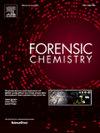Flammable liquids in non-flammable products as potential interferences in the determination of ignitable liquid residues in fire debris
IF 2.6
3区 医学
Q2 CHEMISTRY, ANALYTICAL
引用次数: 0
Abstract
The clothing of suspected arsonists is often analyzed for the presence of ignitable liquids. Personal care products (PCPs) are ubiquitous in our society and can contaminate clothing, so their potential interference is an important consideration in the interpretation of casework samples. Thirty-two samples of various hygiene products and hand cleaners were analyzed using headspace concentration-gas chromatography/mass spectrometry (GC/MS). Despite occasionally containing one or two hydrocarbon compounds found in ignitable liquids, all the antiperspirants and deodorants were readily distinguished from ignitable liquids because they lacked any of the key diagnostic features of ignitable liquids in their extracted ion profiles (EIPs). Two samples labeled as hand cleaners displayed characteristic patterns of heavy petroleum distillates, which, if found on a suspect’s clothing, could cause the misleading assumption that the source of the liquid was flammable. However, the petroleum distillates in these two hand-cleaning products were not flammable, according to both their packaging and safety data sheets, because they were formulated as emulsions with water. This study also includes a casework example of a heavy petroleum distillate in a fire debris sample. However, the co-presence of abundant fatty acid methyl esters increased the probability that the original source was either a biodiesel blend or a non-flammable formulation product and therefore raises reasonable doubt about the flammability of the original product. The results of this work are limited by the GC/MS method, which could not detect volatiles like acetone, propanol, and ethanol eluting before a retention index of 700 nor non-volatile emulsifiers/surfactants.

不可燃产品中的可燃液体作为测定火灾碎片中可燃液体残留物的潜在干扰
通常要对纵火嫌疑人的衣服进行分析,看是否有可燃液体。个人护理产品(pcp)在我们的社会中无处不在,可能会污染衣服,因此它们的潜在干扰是解释案例工作样本的重要考虑因素。采用顶空气浓度-气相色谱/质谱联用技术对32份卫生用品和洗手液样品进行了分析。尽管在可燃液体中偶尔含有一到两种碳氢化合物,但所有止汗剂和除臭剂都很容易与可燃液体区分开来,因为它们在提取离子谱(eip)中缺乏可燃液体的任何关键诊断特征。两个标记为洗手液的样品显示出重质石油馏分的特征模式,如果在嫌疑人的衣服上发现,可能会导致错误的假设,即液体的来源是可燃的。然而,根据它们的包装和安全数据表,这两种洗手产品中的石油馏分物是不易燃的,因为它们是用水制成的乳液。本研究还包括一个火灾碎屑样品中重质石油馏分的案例。然而,大量脂肪酸甲酯的同时存在增加了原始来源是生物柴油混合物或不可燃配方产品的可能性,因此对原始产品的可燃性提出了合理的怀疑。本工作的结果受到GC/MS方法的限制,该方法在保留指数为700之前不能检测丙酮、丙醇和乙醇洗脱等挥发物,也不能检测非挥发性乳化剂/表面活性剂。
本文章由计算机程序翻译,如有差异,请以英文原文为准。
求助全文
约1分钟内获得全文
求助全文
来源期刊

Forensic Chemistry
CHEMISTRY, ANALYTICAL-
CiteScore
5.70
自引率
14.80%
发文量
65
审稿时长
46 days
期刊介绍:
Forensic Chemistry publishes high quality manuscripts focusing on the theory, research and application of any chemical science to forensic analysis. The scope of the journal includes fundamental advancements that result in a better understanding of the evidentiary significance derived from the physical and chemical analysis of materials. The scope of Forensic Chemistry will also include the application and or development of any molecular and atomic spectrochemical technique, electrochemical techniques, sensors, surface characterization techniques, mass spectrometry, nuclear magnetic resonance, chemometrics and statistics, and separation sciences (e.g. chromatography) that provide insight into the forensic analysis of materials. Evidential topics of interest to the journal include, but are not limited to, fingerprint analysis, drug analysis, ignitable liquid residue analysis, explosives detection and analysis, the characterization and comparison of trace evidence (glass, fibers, paints and polymers, tapes, soils and other materials), ink and paper analysis, gunshot residue analysis, synthetic pathways for drugs, toxicology and the analysis and chemistry associated with the components of fingermarks. The journal is particularly interested in receiving manuscripts that report advances in the forensic interpretation of chemical evidence. Technology Readiness Level: When submitting an article to Forensic Chemistry, all authors will be asked to self-assign a Technology Readiness Level (TRL) to their article. The purpose of the TRL system is to help readers understand the level of maturity of an idea or method, to help track the evolution of readiness of a given technique or method, and to help filter published articles by the expected ease of implementation in an operation setting within a crime lab.
 求助内容:
求助内容: 应助结果提醒方式:
应助结果提醒方式:


